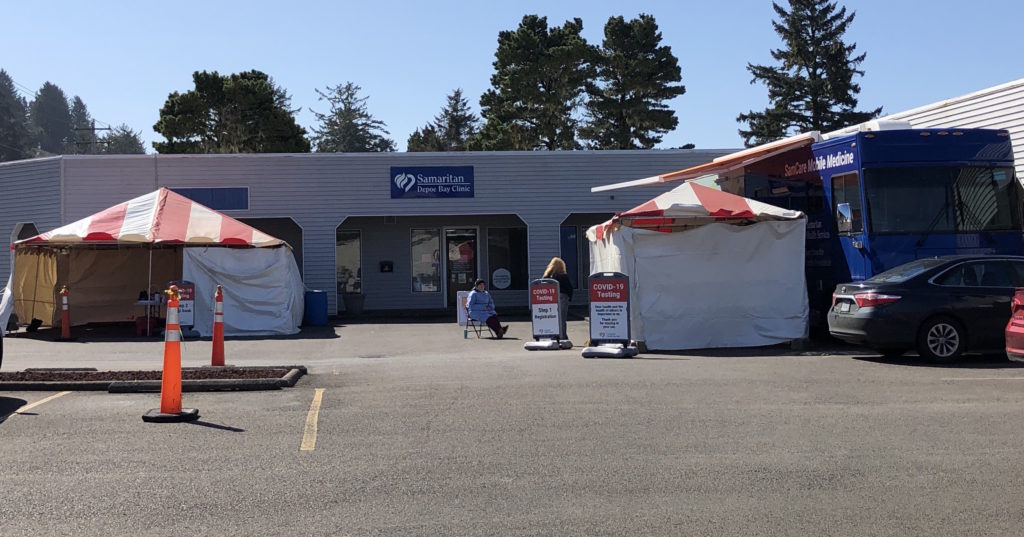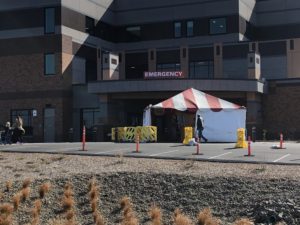
By QUINTON SMITH/YachatsNew.com
The head of coronavirus task force for Samaritan Health Services says the group of five hospitals – after weeks of issues — has improved the availability of COVID-19 tests and is now getting results more quickly.
After initially using the state’s laboratory for tests in March, then turning to two out-of-state labs, Dr. Adam Brady says Samaritan Health is now sending all out-patient tests to Legacy Laboratories in Portland. Tests results are back within 48 hours, Brady said, a big improvement over the three to five days it took with the out-of-state labs.
“It’s really helped out turnaround time,” Brady said in an interview with YachatsNews.

Samaritan’s testing – like that in all of Oregon – is still limited to people referred by their doctor or who go through a screening by a hospital clinician. Increasing the volume of testing to anyone who wants one is a key to fully reopening Oregon to personal and business activity.
“We’re cautiously optimistic we have enough to do the required testing,” Brady said.
In Lincoln County, Samaritan has set up a drive-through testing site in the parking lot of its clinic in Depoe Bay. The drive-through clinic limits potential exposure by keeping people in their car as a heavily protected technician swab their nose.
But, Lincoln County has one of the lowest coronavirus testing rates in the state. According to the Oregon Health Authority there have been 272 tests through Wednesday, April 15 and currently averaging about 12 a day. There are just three confirmed positive results in Lincoln County, population 50,000.
Clatsop County, population 40,000, has had 285 tests and six confirmed cases; Tillamook, population 27,000, has 166 tests and five cases, and Coos County, population 64,000 has had 347 tests and one confirmed case.
Samaritan operates five hospitals in Lincoln, Benton and Linn counties, including newly built and refurbished hospitals in Newport and Lincoln City.

Samaritan officials said last week that its hospitals have seen revenue decline by at least 50 percent as the state ordered cancellation of elective procedures to marshal medical equipment and prepare for a potential flood of coronavirus patients. That wave of patients has not occurred as Oregon’s social distancing orders and other measures have kept the number of cases and hospitalizations low.
Now, Samaritan and other rural Oregon hospital groups have asked the state for $200 million in relief to help make up for the losses and in some cases, keep them open.
Statewide, the Oregon Health Authority says only 23 percent of people testing positive for COVID-19 are hospitalized and that only one-third of available hospital beds are being used.
Brady said the cut in elective procedures and other non-urgent business means Samaritan system has “a lot more capacity” for patients than it normally does.
“I feel good about our ability to absorb a surge above and beyond what we’ve already seen,” he said.
This week PeaceHealth Oregon began COVID-19 testing for patients who need emergency hospitalization but show no signs of having the novel coronavirus. Such patients arriving at any of PeaceHealth’s four Oregon hospitals — including its Florence facility — now are given nasal swab tests that can identify the presence of the virus within an hour. The intent is to segregate patients with the virus and stop the spread from asymptomatic cases.
Increased testing will be key to reopening society
The issue of testing – the number of tests, who should get them and the speed at providers get results – is at the core of questions when states or the federal government should ease restrictions on people and businesses.

Oregon health officials believe the current restrictions should last at least another month. Oregon’s latest modeling shows that while the number of cases has plateaued, there will likely not be a decrease in cases for at least six weeks. Oregon’s overall testing capacity has not grown for two weeks, The Oregonian reported this week.
The Institute for Disease Modeling in Washington state, which has developed projections of Oregon’s coronavirus caseload, stressed the “urgent need for enormously increased testing capacity” before the state considers easing social distancing efforts.
On Tuesday, Oregon Gov. Kate Brown announced the state’s initial framework for lifting statewide closures, saying she would take a slow, science-based approach to deciding how to move forward, without specifying a date when it would happen. The governor wants five things to be in place before gradually lifting stay-at-home restrictions: A declining growth rate of active cases, sufficient personal protective equipment for healthcare workers, surge capacity in hospitals, increased testing capacity, tracing and isolating positive cases, and strategies to protect vulnerable communities including nursing homes and the homeless population.
State epidemiologist Dean Sidelinger said to reopen, Oregon would need the capability to do 15,000 tests a week, 2,100 a day, not the ability to test every Oregonian. Oregon has been testing about 1,300 people a day for the last three weeks.
Brady said now that Samaritan has a reliable place to send its tests, the other issue for it is the number of available test kits.
“Right now we’re comfortable with our supply,” he said. “We’re not refusing any requests for testing. But the supply chain of all these things has been disrupted nationwide.
“Our goal, at least from a public health standpoint, is to test everybody … but supply chain issues aren’t allowing that yet.”
But Brady said there won’t soon be tests for people not showing coronavirus symptoms. Some epidemiologists believe that 25 percent of all people are carrying – and passing along — the virus but not showing symptoms.
Brady said the limited testing is a “source of frustration” for many people who are asking physicians for tests or want to reassure family, friends or co-workers that they are OK. That frustration has eased somewhat, he said, as Oregon’s social distancing efforts and other directives has slowed the coronavirus spread.
“But we have to guard the availability of these tests,” he said. “We want to test when it can help inform (patient) care. My goal would be to test everyone in the community who has symptoms of COVID-19.”


